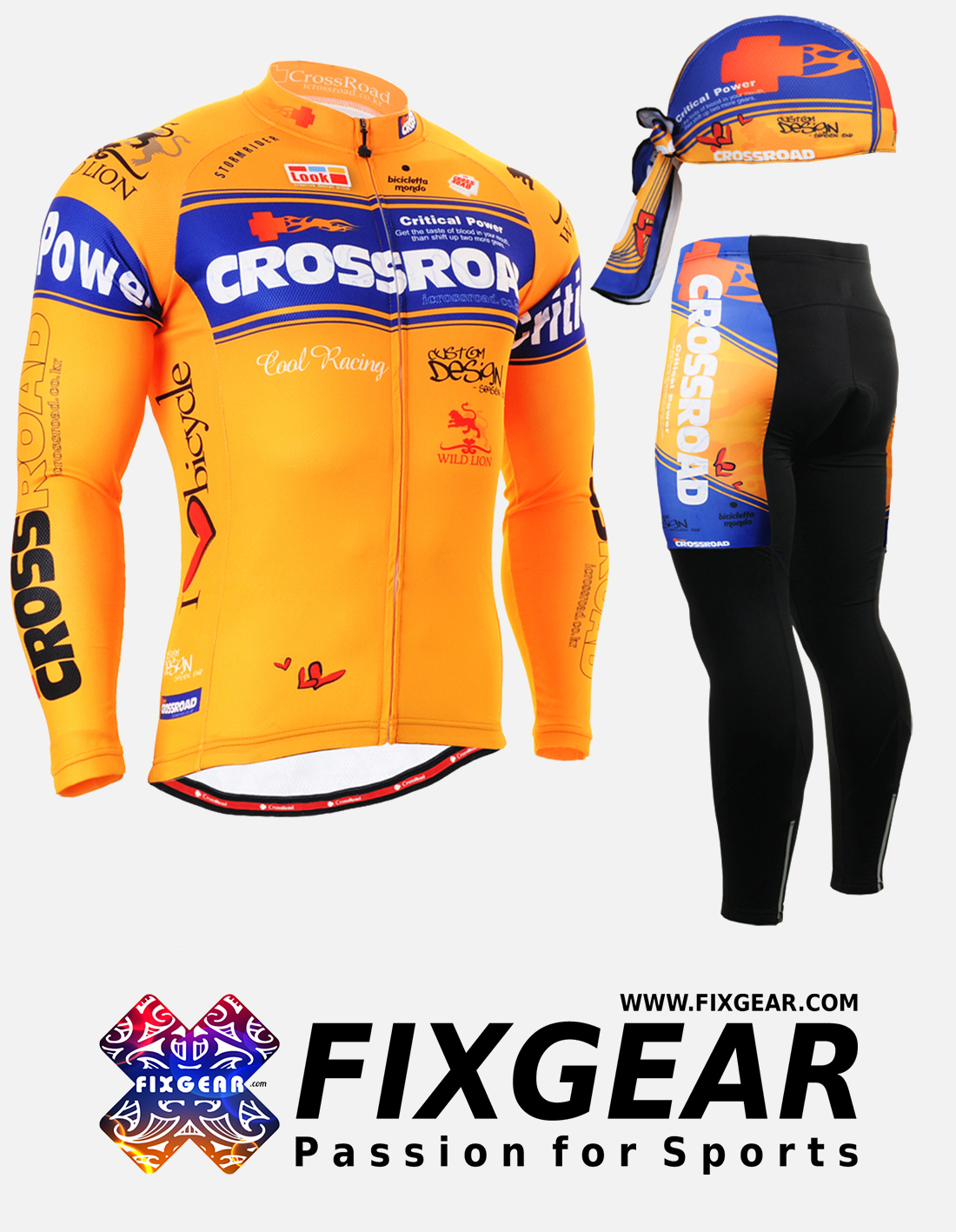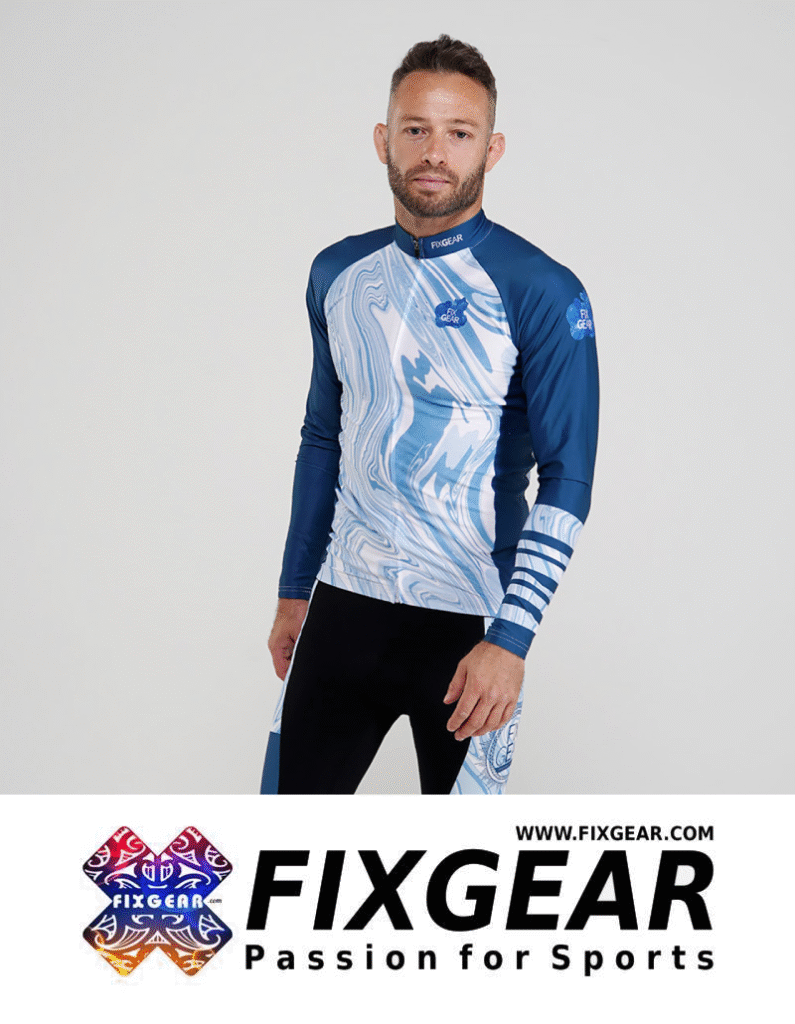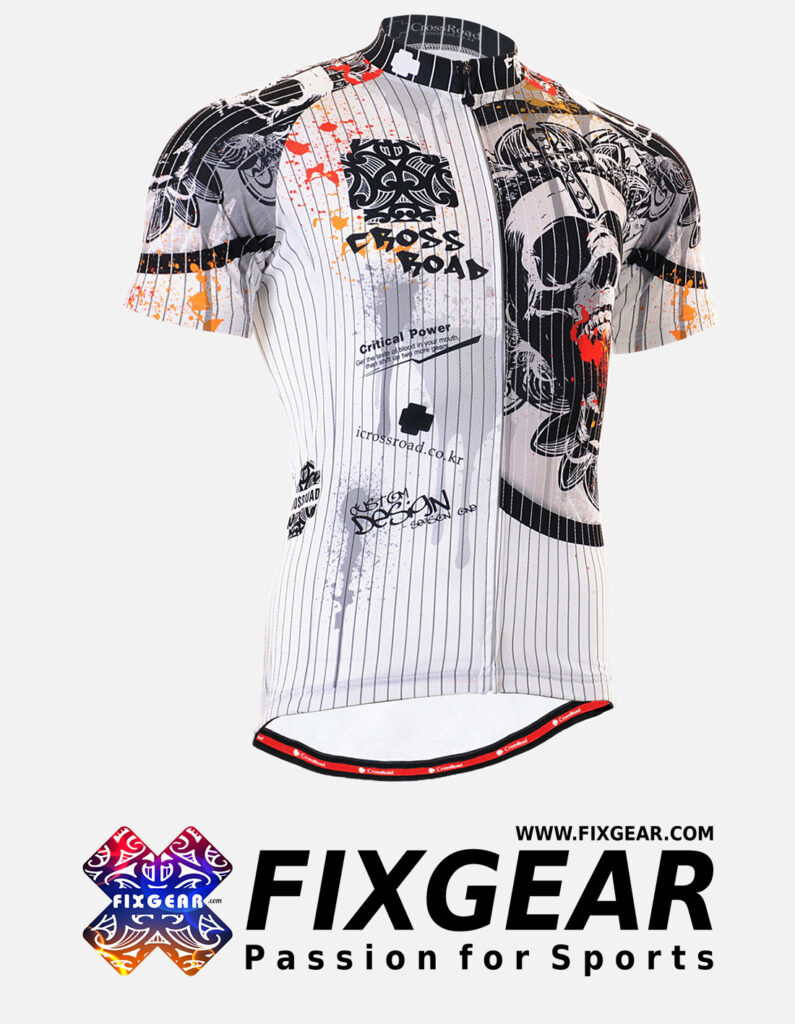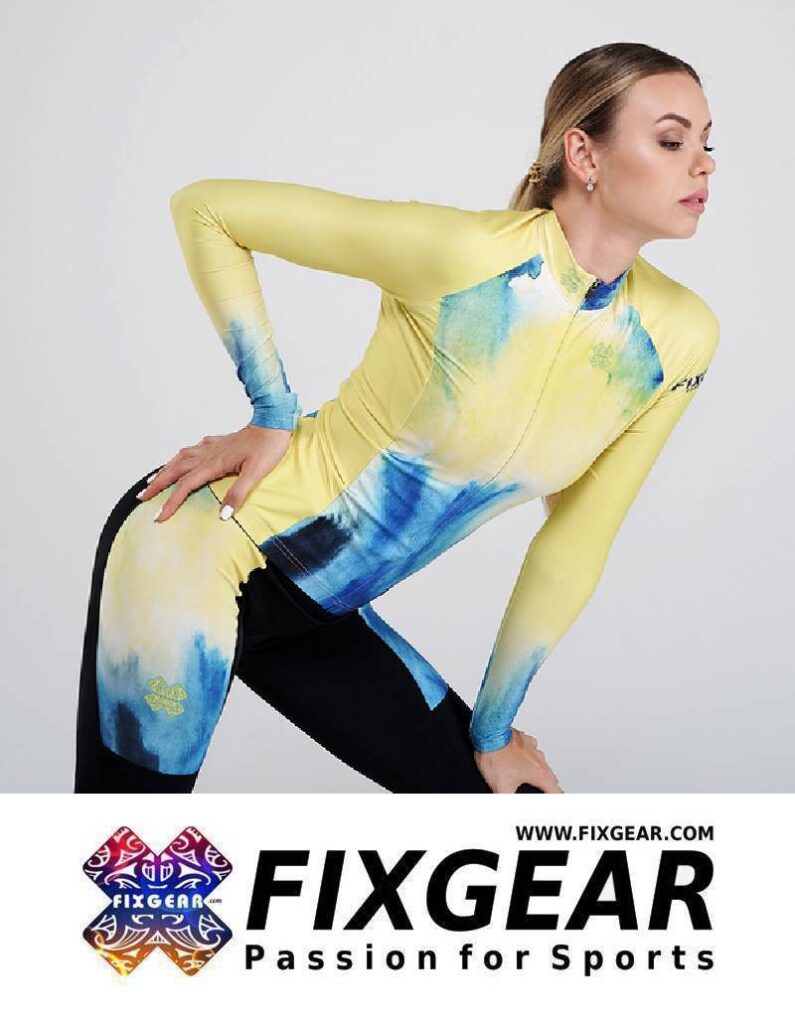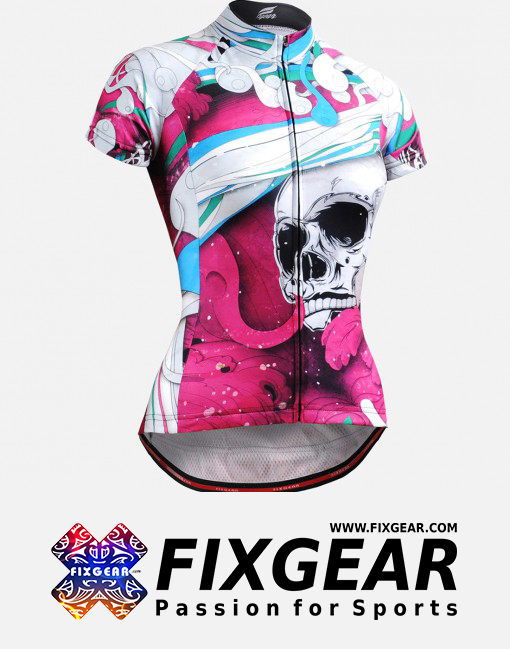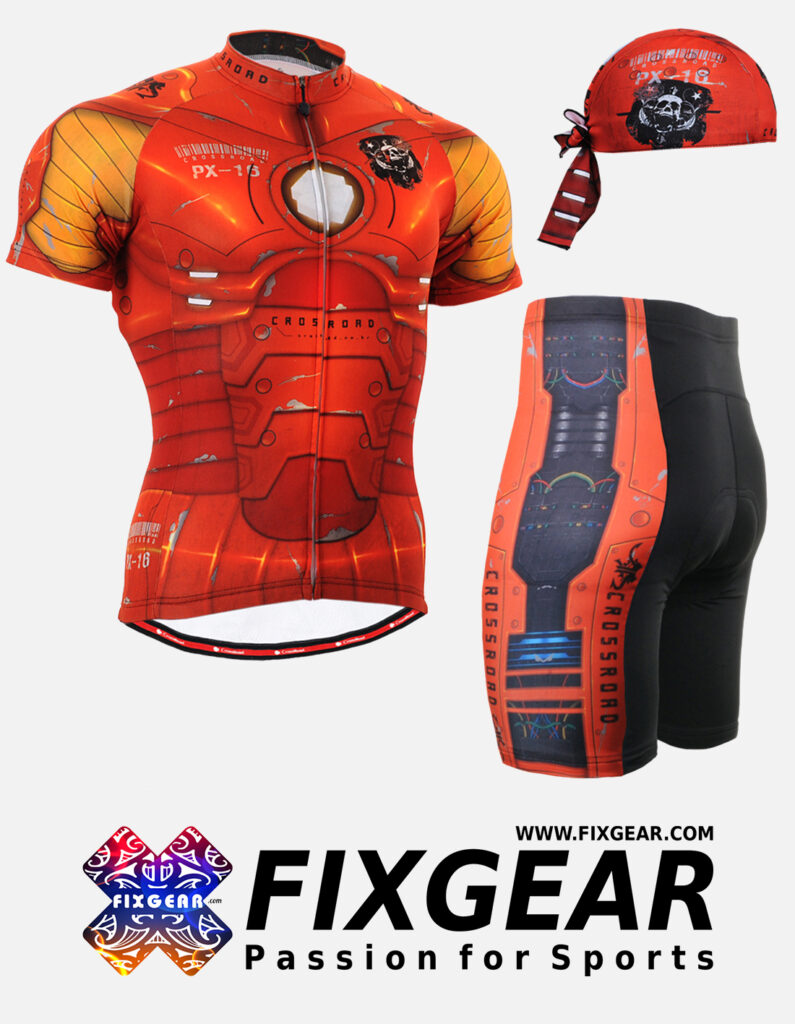The best materials for cycling clothes include:
1. Synthetic Fabrics (e.g., Polyester, Nylon): These materials are lightweight, moisture-wicking, and quick-drying, making them ideal for cycling. They help regulate body temperature and keep you dry during rides.
2. Merino Wool: This natural fibre is breathable, moisture-wicking, and temperature-regulating, making it suitable for cycling in warm and cool weather.
3. Spandex (or Lycra): Often blended with other fabrics, spandex provides stretch and a snug fit, which is essential for comfort and aerodynamics while cycling.
4. Softshell and Windproof Fabrics: These materials protect against wind and light rain for outer layers, keeping you comfortable during unpredictable weather.
Choosing the right material often depends on the weather conditions and personal comfort preferences.
1 – What fabric is often worn by cyclists?
Cyclists often wear the following fabrics?
1. Polyester: A popular choice for cycling jerseys and shorts due to its moisture-wicking properties and durability.
2. Nylon: Known for its strength and abrasion resistance, it’s often used in cycling shorts and jackets.
3. Spandex (Lycra): Provides stretch and a snug fit, commonly blended with other fabrics for cycling apparel.
4. Merino Wool: Favored for its natural insulation and breathability, making it suitable for various temperatures.
5. Softshell Fabrics: Used for outer layers to provide wind and water resistance while maintaining breathability.
2 – Can I wear normal clothes to cycle?
Yes, you can wear regular clothes while cycling, but there are some considerations:
1. Comfort: Regular clothes may not provide the same level as cycling-specific gear. Look for breathable fabrics and a fit that allows for movement.
2. Fit: Loose-fitting clothes can get caught in the bike chain or wheels, so choosing fitted items is safer.
3. Moisture Management: Regular cotton clothes can absorb sweat and become heavy. If possible, opt for synthetic fabrics.
4. Visibility: Bright or reflective clothing can enhance your visibility to others on the road.
5. Layering: Layering with regular clothes can be effective in cooler weather, but ensure that the layers are suitable for active movement.
While regular clothes can work for casual rides, investing in cycling-specific apparel can enhance your comfort and performance.
3 – Is polyester suitable for biking?
Yes, polyester is an excellent material for biking. Here are some reasons why:
1. Moisture-Wicking: Polyester effectively pulls sweat away from the body, keeping you dry and comfortable during your ride.
2. Quick-Drying: The fabric dries quickly, which is beneficial if you encounter heavy rain or sweat.
3. Durability: Polyester is strong and resistant to stretching and shrinking, making it a long-lasting choice for cycling apparel.
4. Breathability: Many polyester fabrics are designed to allow air circulation, helping to regulate body temperature.
5. Lightweight: Polyester is lightweight, which enhances comfort and reduces bulk during rides.
Polyester is widely used in cycling jerseys, shorts, and other gear due to its advantageous properties.
4 – What do professional cyclists wear?
Professional cyclists typically wear:
1. Cycling Jerseys: Made from moisture-wicking fabrics like polyester, these jerseys are designed to keep cyclists dry and comfortable while providing a snug fit for aerodynamics.
2. Bib Shorts: These provide support and comfort, with chamois (padding) for protection against saddle soreness. They are preferred over regular shorts for their fit and lack of waistband.
3. Cycling Shoes: These stiff-soled shoes allow efficient power transfer while pedalling. Many have clipless systems to secure the foot to the pedal.
4. Arm and Leg Warmers: These are used to regulate body temperature and can be easily removed if conditions change.
5. Gloves: Fingerless or full-fingered gloves provide grip and comfort, reducing fatigue during long rides.
6. Helmets: A critical safety component, professional cyclists wear lightweight and well-ventilated helmets to protect their heads.
7. Sunglasses: They wear sunglasses designed for cycling to protect their eyes from UV rays and debris.
8. Wind and Rain Jackets: Lightweight and packable, these jackets protect against wind and rain in variable weather conditions.
Overall, the attire of professional cyclists is specifically designed for performance, comfort, and safety.
5 – Why are cycling clothes black?
Cycling clothes are often black for several reasons:
1. Heat Absorption: Black clothing absorbs heat, which can be beneficial in colder conditions, helping to keep cyclists warm during rides.
2. Stain Resistance: Black is less likely to show dirt, grease, and stains, making it practical for cyclists who may encounter messy conditions.
3. Aesthetic Appeal: Black is a classic and sleek colour that many find stylish. It often gives a professional and streamlined look.
4. Uniformity: Many teams and clubs choose black as the base colour for jerseys and shorts, promoting a cohesive team appearance.
5. Visibility: While black itself is not highly visible, many cycling kits incorporate bright logos or patterns that contrast against black, allowing for style and safety.
While black is standard, cyclists wear other colours for visibility and personal preference, especially in urban or competitive settings.
6 – What material is best for bike wheels?
The best materials for bike wheels typically include:
1. Aluminum: This is the most common material for bike wheels due to its lightweight nature and good strength-to-weight ratio. Aluminum wheels offer decent durability and are often more affordable.
2. Carbon Fiber: Known for its exceptional strength and lightweight properties, it is often used in high-performance wheels. It provides excellent stiffness and aerodynamics but can be more expensive and less durable under impact than aluminum.
3. Steel: While heavier than aluminum and carbon fibre, steel wheels are known for their durability and strength. They are often found on lower-end bikes or for specific applications such as touring or commuter bikes.
4. Titanium: This material is used less frequently due to its high cost but offers excellent strength, weight, and corrosion resistance. Titanium wheels are typically found on high-end bikes.
The choice of material often depends on the type of cycling, budget, and personal preferences for performance and weight.
7 – Why do cyclings wear short sleeves?
Cyclists often wear short sleeves for several reasons:
1. Temperature Regulation: Short sleeves help keep cyclists cool during warm weather by allowing better airflow and reducing body heat buildup.
2. Range of Motion: Short sleeves provide greater freedom of movement in the arms, essential for maintaining a comfortable and efficient riding position.
3. Moisture Management: Many short-sleeve cycling jerseys are made from moisture-wicking fabrics that help pull sweat away from the body, keeping cyclists dry and comfortable.
4. Aerodynamics: Short sleeves can offer a more aerodynamic fit than longer sleeves, which can benefit competitive cycling situations.
5. Layering Options: Short sleeves allow cyclists to layer easily with arm warmers or jackets when the weather is cooler, providing flexibility in changing conditions.
Overall, short sleeves are a practical choice that balances comfort, performance, and adaptability for cyclists.
8 – What shirts do cyclists wear?
Cyclists typically wear the following types of shirts:
1. Cycling Jerseys: These are specially designed shirts made from moisture-wicking, breathable fabrics. They usually feature a snug fit to enhance aerodynamics and often have pockets for carrying essentials.
2. Short-Sleeve Jerseys: Ideal for warm weather, these jerseys provide airflow and comfort while allowing for ease of movement.
3. Long-Sleeve Jerseys: In cooler conditions, long-sleeve jerseys offer extra warmth and can be layered under jackets or vests.
4. Base Layers: These are tight-fitting shirts worn under jerseys, often made from thermal or moisture-wicking materials to regulate body temperature.
5. Casual Cycling T-Shirts: Some cyclists opt for casual t-shirts made from breathable fabrics for recreational rides, although these may not provide the same performance benefits as dedicated cycling jerseys.
Cycling jerseys are the most common choice among cyclists for their functionality, comfort, and performance features.
9 – What is appropriate clothing for cycling?
Appropriate clothing for cycling includes:
1. Cycling Jerseys: Made from moisture-wicking, breathable fabrics, they keep you dry and comfortable, often featuring pockets for essentials.
2. Bib Shorts or Cycling Shorts: These provide cushioning and chamois (padding) support to prevent saddle soreness. Bib shorts offer additional support with straps that go over the shoulders.
3. Cycling Shoes: Designed for efficient power transfer, these often feature stiff soles and may include a clipless system to attach to the pedals.
4. Layered Clothing: In cooler weather, consider layering with lightweight and windproof long-sleeve jerseys, arm warmers, and jackets.
5. Gloves provide grip and comfort, reducing fatigue on long rides.
6. Helmets: Essential for safety, choose a well-ventilated and properly fitting helmet.
7. Sunglasses: Protect your eyes from UV rays and debris with lenses designed for cycling.
8. High-Visibility Gear: Bright or reflective clothing enhances visibility, especially when riding in traffic or low-light conditions.
Choosing clothing designed for cycling can enhance your comfort, performance, and safety on the road.
10 – How do you choose cycling clothing?
When choosing cycling clothing, consider the following factors:
1. Fit: Look for clothing that fits snugly without being too tight. A proper fit enhances aerodynamics and comfort while allowing for a full range of motion.
2. Fabric: Opt for moisture-wicking, breathable materials that help keep you dry and comfortable. Synthetic fabrics like polyester or blends with spandex are common choices.
3. Weather Appropriateness: Choose clothing suitable for the weather conditions. Lightweight jerseys are great for warm weather, while long sleeves, arm warmers, and jackets are essential for cooler temperatures.
4. Padding: For shorts, consider the level of padding (chamois) based on your riding style and duration. More padding is beneficial for longer rides.
5. Functionality: Look for features like pockets for storing essentials, reflective elements for visibility, and zippers for ventilation.
6. Layering Options: Consider how the clothing will work together. Layering can help you adapt to changing weather conditions.
7. Style and Colour: While performance is key, choose styles and colours you enjoy wearing, as this can enhance your overall cycling experience.
8. Budget: Determine your budget, as cycling clothing can vary widely in price. Investing in quality gear can lead to better comfort and durability.
Considering these factors, you can choose cycling clothing that meets your needs and enhances your riding experience.
11 – Does cycling clothes make you faster?
Yes, cycling clothes can make you faster due to several factors:
1. Aerodynamics: Cycling-specific clothing is designed to be form-fitting, reducing wind resistance. This aerodynamic design helps cyclists move more efficiently through the air, which can lead to increased speed.
2. Moisture Management: Specialized fabrics wick moisture away from the body, keeping cyclists dry and comfortable. This helps maintain body temperature and energy levels, improving performance over longer rides.
3. Comfort: Proper cycling clothing minimizes chafing and discomfort, allowing cyclists to focus on their performance rather than distractions caused by ill-fitting or inappropriate gear.
4. Layering and Temperature Control: Cycling clothes are designed for various weather conditions, helping cyclists maintain an optimal body temperature, which can enhance endurance and speed.
5. Padding and Support: Cycling shorts with padding (chamois) provide comfort during long rides and enable cyclists to maintain a more powerful and efficient pedal stroke.
While the clothing alone won’t drastically change speed, wearing appropriate cycling attire can enhance overall performance, allowing cyclists to ride faster and longer.
12 – What are the layers of cycling you should wear?
When layering for cycling, consider the following layers to ensure comfort and adaptability to different weather conditions:
1. Base Layer:
• Purpose: Worn directly against your skin, the base layer helps wick moisture away from your body.
• Material: Look for synthetic fabrics or merino wool that provide breathability and insulation.
2. Mid Layer:
• Purpose: This layer adds insulation and warmth while allowing moisture to escape.
• Options: Lightweight fleece or thermal jerseys work well as mid-layers, depending on the temperature.
3. Outer Layer:
• Purpose: The outer layer protects against wind, rain, and cold.
• Options: A lightweight, windproof jacket or a waterproof shell is ideal for unpredictable weather. Look for features like vents and pockets for added functionality.
4. Arm and Leg Warmers:
• Purpose: These versatile accessories provide extra warmth and can be easily removed if the temperature rises.
• Material: Typically made from stretchy, breathable fabrics, they can be worn over shorts or under longer pants.
5. Accessories:
• Gloves: Keep your hands warm and improve grip.
• Headwear: A cycling cap or a headband can help with warmth and sun protection.
• Socks: Choose moisture-wicking socks that provide comfort and warmth.
Using these layers, you can adapt your cycling attire to changing weather conditions, ensuring comfort and performance.

